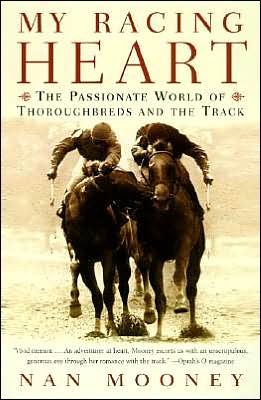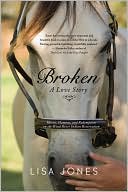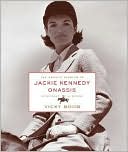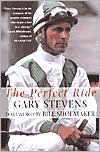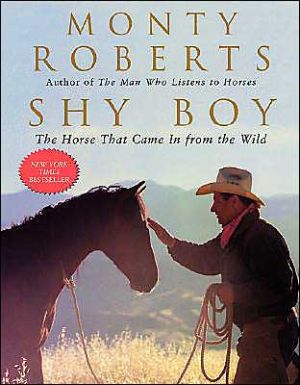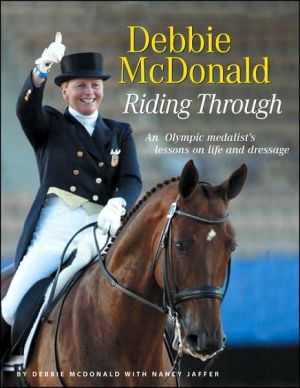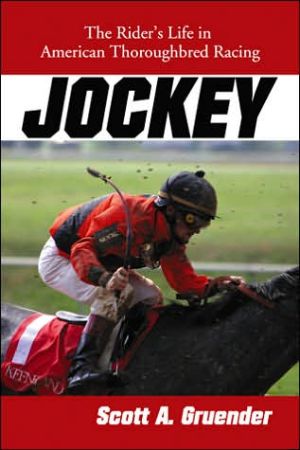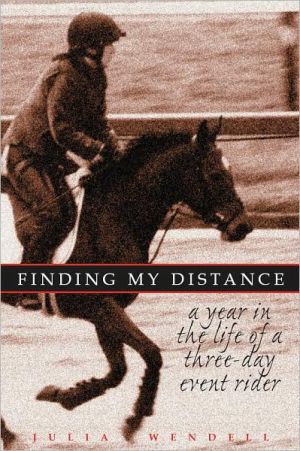My Racing Heart: The Passionate World of Thoroughbreds and the Track
When Nan Mooney was seven years old, she sat in her grandmother May-May's living room to watch her first horse race ... And so began a turbulent romance between a woman and a sport.\ Part memoir, part journey into the compelling world of Thoroughbred horse racing, My Racing Heart gallops headlong into the wild culture and fabulous creatures that rise up around a racetrack. Nan Mooney looks at the horses, jockeys, and trainers; the gambling and corruption; and racing's age-old history and...
Search in google:
When Nan Mooney was seven years old, she sat in her grandmother May-May's living room to watch her first horse race ... And so began a turbulent romance between a woman and a sport.Part memoir, part journey into the compelling world of Thoroughbred horse racing, My Racing Heart gallops headlong into the wild culture and fabulous creatures that rise up around a racetrack. Nan Mooney looks at the horses, jockeys, and trainers; the gambling and corruption; and racing's age-old history and forever offbeat society. From the dusty backstretch at a small-town track to the stands at magnificent Churchill Downs, Nan Mooney captures the risks and the glory, the excitement and the passion, for horse lovers, sports fans, and anyone who has ever craved a place to run wild. Richmond Times-Dispatch “A love poem to racing. . . A fine book and a joy to read.”
Chapter One\ \ \ Trust:\ The Horse of Course\ \ \ May-May fell for Thoroughbreds the same way I would eighty years later -- fully, sweetly, and without hesitation. It happened to me in her living room, kneeling on a square of plum-colored carpet. For May-May, that love first came via a cowboy dream, roaming the plains of the Wild West.\ When May-May was eleven, her grandfather, soured by a post–Civil War South that had emerged as a paper cutout of its former splendor, bought a several-thousand-acre ranch outside the frontier town of Fort Collins, Colorado. The entire family piled into a private railcar and clickety-clacked their way from the new northern money of the Carnegies and Rockefellers to a land where rumor had fading cotton fortunes tripled by raising longhorn cattle.\ May-May's grandmother insisted on uprooting the entire contents of their Spesushi Island plantation. The train churning along the transcontinental tracks towed behind it cargo cars laden with Queen Anne tables, china washbasins, and six four-poster beds. Her grandfather reserved one car only for his horses. Those horses were his pride, four hearty stallions with broad chests and high hindquarters, and a single fourteen-year-old mare, a former racehorse named Madame Queen. She was the one female May-May's grandfather deemed tough enough to survive the thorns and rattlesnakes of Colorado. She was also the only Thoroughbred of the lot.\ Thoroughbred horses are a particular breed, like golden retrievers or Black Angus cattle, and throughout their three-hundred-year historythey've existed for one reason only: to win races. Their most desirable qualities are those of any premier athlete: speed, agility, and the kind of perfectly proportioned bodies that can run river-fast without shattering. Along with such practical facts travel some highly indeterminable variables. The swiftest runners are those with the lightest bodies, leanest muscles, and longest legs, a makeup more characteristic of foals than their full-grown ancestors. Along with those juvenile physical qualities, Thoroughbreds have maintained a few other fragments of the child. They tend to be playful, moody, skittish, and temperamental, easily distracted and even more easily bored. They're expert at flouting authority, permanent adolescents straining at any parental hand. May-May's grandfather bought Madame Queen to breed her, hoping to infuse his heftier carriage horses with some of her whip-speed and fine-boned beauty, and Madame Queen proved pure Thoroughbred indeed. She boasted near perfect conformation -- legs arrow-straight from shoulder to knee to ankle, muscular haunches to propel her forward, a neck that rose from her shoulders at just the right angle to balance the weight of her body as she moved. She was also a holy terror.\ Madame Queen belonged to May-May, not as a gift or even a privilege, but because eleven-year-old Mary Stuart -- who'd cut her riding teeth on a series of unruly ponies'was the only one who could stay atop the mare's back. In Maryland, their relationship had been limited to afternoons marking off the well-known confines of Spesushi Island, but in Colorado all that would change. While the boys carried pail lunches off to the one-room Fort Collins schoolhouse, May-May and the other granddaughters spent each morning in the nursery under the eye of an imported governess. Afternoons were their own, provided they didn't mix with the undesirable local children. For once, May-May harbored no interest in defiance. Every day at two o'clock, she donned one of her brother's oversize flannel shirts, slipped through the split-rail fences surrounding the family's log house, and darted across the dirt road to the barn and Madame Queen. A few minutes later, they were saddled up and set free.\ Wandering those Colorado prairies, May-May and Madame Queen forged the sort of trust necessary for survival. When May-May lost her way during night rides through the sagebrush, Madame Queen raised her nose and led them home. When Madame Queen twisted a delicate ankle in a gopher hole, May-May swung off the saddle to walk them the seven miles back to the ranch, then packed Madame Queen's leg with homemade poultices every day for a week, drawing off heat and letting the injury heal. During the stark summer heat and lightning storms, May-May slept outside Madame Queen's stall as the horse bucked and spun and lashed out at the walls, a handful of her high-strings finally snapping loose. In the summer they would disappear overnight, May-May bedding down in the old settlers' cabins that dotted the property, then ducking into the schoolroom the next morning to await the inevitable booming voice of grandfather.\ “Mary Stuart.”\ “Yes, sir.”\ She would shuffle off to his paneled office and sit in one of the imported high-back chairs with her feet dangling just above the ground. He didn't smack her with the wooden rod propped in the corner. Such punishment was saved for the boys. He would simply ask:\ “Have you disobeyed me?”\ “Yes, sir.”\ “And will you do so again?”\ “Not if I can help it.”\ The two of them had fought the same battle too often for him to insist upon anything further. By that time he knew, maybe even admired, May-May's bent for rebellion. For all his rigid opinions, he made no move to clip those first green shoots of self-confidence. Instead, after a few months, he began to develop urgent business requiring his attention elsewhere on the property, always disappearing on those very mornings May-May slipped in at dawn with Madame Queen.\ May-may's family stayed in Colorado for only two years, a wedge of frontier heaven that slammed shut when her grandfather's fresh fortune didn't manifest itself and he grew bored with the wide-open plains. As they packed up to return to Baltimore, a neighboring rancher offered to buy Madame...\ My Racing Heart. Copyright © by Nan Mooney. Reprinted by permission of HarperCollins Publishers, Inc. All rights reserved. Available now wherever books are sold.
Acknowledgments and ExplanationsixIntroduction: An Unconventional Romance1Part 1The Starting GateChapter 1Trust: The Horse of Course23Chapter 2Rewriting the Rules: The Front Men--Trainers and Owners54Chapter 3Leaps of Faith: Playing the Breeding Game89Part 2Early SpeedChapter 4Courage: Riding High--The Jockey's Life127Chapter 5Generosity: Breaking onto the Backstretch159Part 3The Stretch RunChapter 6Risking It All: The Art of Gambling187Chapter 7Unconditional Love: The Anatomy of a Racing Fan216Chapter 8Forming a Value System: Hustles, Fixes, and the Drug Controversy235Part 4Crossing the WireChapter 9Connections: Chasing the Kentucky Derby265Chapter 10Growth: The Future of the Track284Epilogue: The Heartbeat303Photograph Credits307
\ Bill Littlefield"Exceptional writing. Extraordinary. The story she has to tell simply could not have been told more brilliantly."\ \ \ \ \ New York Times Book Review"[Mooney] is an ambitious writer . . . . she manages to cash her share of winning tickets."\ \ \ Washington Post"We’re off on a lovely ride. By the time [Mooney’s] heading for home she’s got us cheering her on."\ \ \ \ \ Booklist"Deeply felt. Will prod the curious to investigate what it is about this sport that can inspire such love."\ \ \ \ \ Richmond Times-Dispatch"A love poem to racing. . . A fine book and a joy to read."\ \ \ \ \ USA Today"Mooney embraces the best parts of the horse world. It’s hard not to join her in this love affair."\ \ \ \ \ Daily Racing Form"Mooney has sliced open her soul and let the horse run free. Her words are intoxicating. Her stories glow."\ \ \ \ \ Hartford Courant"This is a confession and a love story, with all the fear and second-guessing that those bring."\ \ \ \ \ O magazine“Vivid memoir . . . Mooney escorts us with an unscrupulous, generous eye through her romance with the track.”\ \ \ \ \ Seattle Post-Intelligencer"An engaging introduction to the lure of the racetrack. [And] a confirmation of horseracing’s gritty glamour."\ \ \ \ \ O Magazine"Vivid memoir . . . Mooney escorts us with an unscrupulous, generous eye through her romance with the track."\ \ \ \ \ Library JournalThis thoroughbred horse-racing memoir repeats much of what has been previously written about racing; it describes how race horses are bred, raced, and disposed of and offers anecdotes about jockeys, trainers, owners, and grooms. However, this account is unique in that Mooney tells how she came to love racing at her grandmother's knee, how her relationships with her grandmother and racing developed side by side, and how she gave up her passion for racing for a time after her grandmother's death. Mooney explains how, despite some of the sport's negative aspects, she loves the beauty and unpredictability of the horses, the risks and the excitement, and the fact that racing has both never-changing and ever-changing aspects. Mooney writes for the Blood-Horse, the journal of record for thoroughbred horse racing. Readers who enjoyed Joe Drape's The Race for the Triple Crown (LJ 4/15/01) and John McEvoy's Women in Racing: In Their Own Words (LJ 9/01/01) will appreciate this one. Recommended for medium to large public libraries and libraries with racing collections. Patsy E. Gray, Huntsville P.L., AL Copyright 2001 Cahners Business Information.\ \ \ \ \ Kirkus ReviewsA wonderfully expressive love story between Mooney, who writes for The Blood-Horse magazine, and that permanent adolescent of the horse world, the thoroughbred. Mooney made the acquaintance of the racetrack through the inspired guidance of her grandmother, May-May, who knew everything there was to know about the track, having spent hours as a youth draped over the fence at Pimlico watching the horses and cut her teeth at the trotting tracks in Maryland. She gave the bug wholesale to her granddaughter, but when May-May died, so did Mooney's attachment to the sport. In a graceful, forward style, Mooney traces her return to the racetrack to a broadcast of the Kentucky Derby she happened on while shopping at Radio Shack. Immersing herself in that world once again, she brings it, with great respect, to the reader. The elusive romance of the trainer's life is typified by the trailblazing John Nerud and the intuitive, freewheeling Bob Baffert. Mooney charts the careers of two peerless riders, Angel Cordero Jr. and Donna Barton; salutes hotwalkers and grooms like Cleevie, who knows how to make a horse shine in bloom; and nods at the gamblers and the handicappers. She makes it clear she's on the side of the risk-takers, for "to urge a horse to come into second or third seemed to run counter to our entire relationship." There is the dreadful downside of drugged horses, drugged jockeys, and fixed races, but there is also the sheer glory of the animals, the "playful, moody, skittish, and temperamental, easily distracted and even more easily bored" thoroughbreds, which also happen to be sensitive, elegant, and impossible to tame. A fine introduction to the racetrack that's also a dazzlingly successfulblind date, deeply and unexpectedly satisfying, between readers and thoroughbreds. (b&w photos throughout) Author tour\ \
